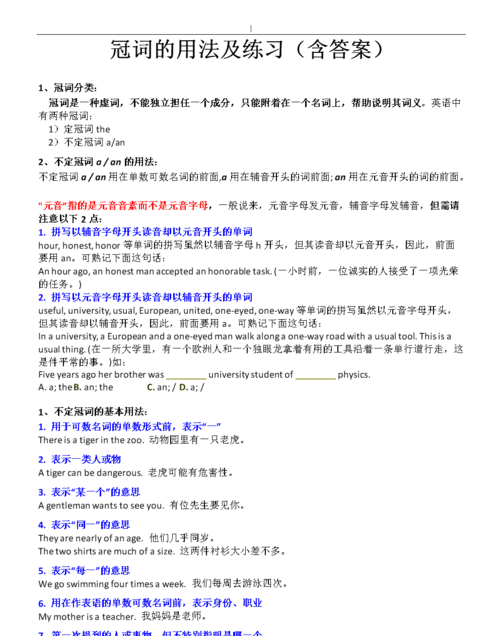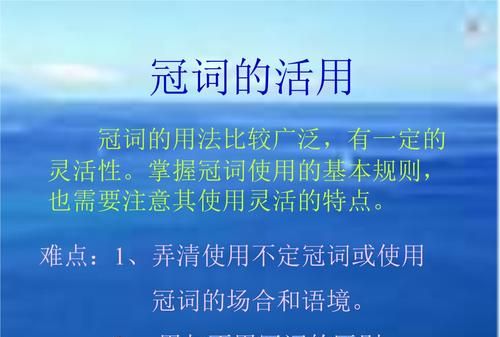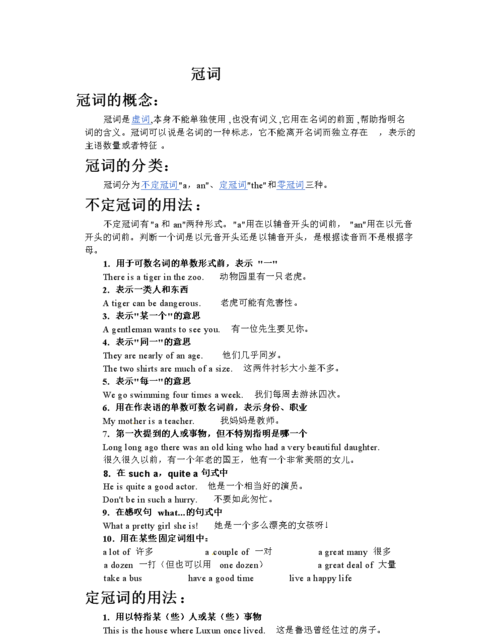本文目录
高中英语冠词语法知识点总结
定冠词表示名词为特定者,与该名词表示的其他人或事物区别开,可根据实际情况翻译成“这”“那”“这些”“那些”,或不翻译,接下来我给大家分享关于英语冠词语法的知识,希望对大家有所帮助!
英语冠词语法的知识1
a和an的区别
不定冠词有a和an两种形式,a用于辅音(不是辅音字母)开头的词前,an用于元音(不是元音字母)开头的词前。
例如:a boy,a university;an hour,an apple,an umbrella
不定冠词的用法
1.泛指某一类人、事或物,这是不定冠词a/an的基本用法。
A knife is a tool for cutting with.
Mr. Smith is an engineer.
2.泛指某人或某物,但不具体说明何人或何物。
A Mr. Li is waiting for you.
一位李先生在等你。
3.表示数量,有“一”的意思,但数的概念没有one强烈。
There is a book on the desk.
书桌上有一本书。
4.表示“每一”,相当于every.
I go to school five days a week.我一周上五天课。
5.用在序数词前,表示“又一”,“再一”。
I have three books. I want to buy a fourth one.
我已经有三本书,我想买第四本。
6.用在某些固定词组中
用与不用冠词的差异
in hospital住院/in the hospital在医院里
go to sea出海/go to the sea去海边
on earth究竟/on the earth在地球上,在世上
in front of在……(外部的)前面/in the front of在……(内部的)前面
take place发生/take the place(of)代替
at table进餐/at the table在桌子旁
by sea乘船/by the sea在海边
in future从今以后,将来/in the future未来
go to school(church…)上学(做礼拜…)/go to the school (church…)到学校(教堂…)去
on horseback骑着马/on the horseback在马背上
two of us我们当中的两人/the two of us我们两人(共计两人)
out of question毫无疑问/out of the question不可能的,办不到的
next year明年/the next year 第二年
a teacher and writer一位教师兼作家(一个人)/a teacher and a writer一位教师和一位作家(两个人)
英语冠词语法的知识2
定冠词的用法
1.特指某(些)人或某(些)物,这是定冠词的基本用法。
The girl under the tree is my sister.
树下的女孩是我妹妹。
2.指谈话双方都知道的人或事物。
Open the window,please.请打开窗户。
3.指上文已经提到的人或事物。
I have a car. The car is red.
我有一辆小汽车,它是红色的。
4.指世界上独一无二的事物。
Which is bigger,the sun or the earth?
哪一个大,太阳还是地球?
5.用在序数词,形容词最高级前。
The first lesson is the easiest one in this book.
第一课是这本书最简单的一课。
6.用在由普通名词构成的专有名词前。
the great wall 长城,the united states美国
7.用在某些形容词前,表示某一类人。
the poor穷人,the blind盲人
8用在姓氏复数形式前,表示“全家人”或“夫妻俩”。
the Greens 格林一家或格林夫妻俩
9.用在方位词前。
on the left在左边,in the middle of在中间
10.用在乐器名称前。
She plays the piano every day.她每天弹钢琴。
11.用在表示海洋,河流,山脉,群岛及国家和党派等名词前。
the black sea黑海,the yangzi river长江
12.用在某些固定词组中
英语冠词语法的知识3
零冠词的用法
1.在专有名词和不可数名词前。
Class two二班,Tian’an men square天安门广场,water水
2.可数名词前已有作定语的物主代词(my,your,his,her等)、指示代词(this/these,that/those)、不定代词(some,any等)及所有格限制时。
my book(正);my the book(误)
3.复数名词表示一类人或事物时。
They are teachers.他们是老师。
Tigers like meat.老虎喜欢吃肉
4.在星期,月份,季节,节日前。
on sunday在周日,in march在三月,in spring在春天,on women’s day在妇女节
(特例:如果月份,季节等被一个限定性定语修饰时,则要加定冠词:he joined the army in the spring of 1982.他在1982年春季参军。)
5.在称呼语或表示头衔的名词前。
Tom汤姆,mum妈妈
6.在学科名称、三餐饭和 球类运动 名称前。
I have lunch at school every day.
特例:当football,basketball指具体的某个球时,其前可以用冠词:i can see a football.我可以看到一只 足球 。where’s the football?那只足球在哪儿?(指足球,并非“球类运动”)
7.在表特定的公园,街道,车站,桥,学校等之前。
No.25 middle school
8.某些固定词组中不用冠词。
(1)与by连用的交通工具名称前:by bus乘公共汽车;by car乘汽车;by bike骑/坐自行车;by train乘火车;by air/plane乘飞机;by sea/ship乘船,但take a bus,in a boat,on the bike前需用冠词
(2)名词词组:day and night日日夜夜;brother and sister兄弟姐妹;hour after hour时时刻刻;here and there到处
(3)介词词组:at home在家;in surprise惊奇地;at noon在中午;on foot步行;at night在晚上;on duty值日;at work在工作;on time准时;for example例如;in class在上课;on show展览;in bed在床上
(4)go 短语 :go home回家;go to bed上床睡觉;go to school去上学;go to work去上班;go shopping/swimming/boating/fishing去买东西/ 游泳 /划船/钓鱼
英语冠词语法的知识点相关 文章 :
★ 英语冠词的语法归纳
★ 英语冠词的常见用法归纳详解
★ 高考英语语法填空冠词知识点与谓语动词表
★ 初中英语冠词的语法归纳
★ 英语定冠词的知识点
★ 小学英语语法知识点:定冠词the用法讲解
★ 英语基础语法:定冠词知识内容总结
★ 英语语法知识点总结
★ 最新小升初英语冠词的知识点总结+冠词知识点
★ 英语语法介词语法知识点


高中英语名词冠词代词的知识点总结
高中英语冠词语法知识点总结
高中常用的冠词有哪些呢?下面由我为大家整理的高中英语冠词语法知识点总结,欢迎大家查看!

冠词
高考对冠词的考查集中在基本用法上,主要既反映在对泛指、特指及固定短语 冠词的考查。抽象名词、物质名词的具体化依然是高考的重点、难点。
一、不定冠词
不定冠词a,an与one同源,表示微弱的一的概念,但并不强调数目,用来表示不确定的人或事物。
A用在辅音前,而不是辅音字母前;an用在元音前,而不是元音字母前。
a university in Asia
1.表示同类中的任何一个
A cat has nine lives.
2.表示泛指的某人、某物
I know a John Lennon,but not the famous one.
3.表示数量的一 He has a daughter.
4. 表示单位数量的每一 I earn 10 dollars an hour.
5.表示相同的
The two birds are of a color.
6. 用于集体名词前
He grows up in a large family.
7. 在某种情况下可用于抽象名词和物质名词前 China has a long history.
二、定冠词的用法
1.表示特定的人或物
2.表示地球、宇宙中独一无二的事物
主要指各种天体及世界上比较有影响的物体。 The sun,the moon,the earth
3.表示地点、方向、时间、方式等 at the corner 在拐角处
1) 在表示季节的名词前常不用冠词。 In spring 在春天
2) 具体某年的某个季节,需用冠词。 In the summer of the year2008
3)用于序数词或形容词的最高级前 the first the second
4)用于形容词前使其名词化 the rich the poor
5)用于复数姓氏前,表示―夫妇‖或全家 The Smiths
6)用于乐器名词前 Play the piano
7)用于by+the+计量单位名词 By the pound
1. 用于复数名词前
复数名词泛指某类人或物时,其前通常用零冠词。 Students should obey the school rules. 学生应该遵守校规。 复数名词若需特指,则要加定冠词。 The students are too lazy. 这些学生太懒。
2. 用于不可数名词前
不可数名词表示泛指时,其前通常用零冠词。如: Bread is made from flour. 面包是用面粉做的。
Wood is a poor conductor of sound. 木头是声音的不良导体。 不可数名词若需特指,则要加定冠词。
He sawed the wood into three pieces. 他把木头锯成三块。
3.用于专有名词前
在通常情况下,专有名词前要用零冠词。如:
Mr Smith is our English teaches us English. 史密斯先生教我们英语。 在特殊情况下,若专有名词需要特指,也可加定冠词。如: The Smith you‘re looking for no longer lives here.
4. 用于抽象化的可数名词前
有些可数名词抽象化后表示表示的活动,其前通常零冠词。 Jim has gone to bed. 吉姆已上床睡觉了。
She goes to church every Sunday. 她每周星期天都去做礼拜。
这类主要涉及bed, church, class, college, school, university, work, hospital, prison, market, sea, town等。另外,这类名词前用不用冠词有时与英美英语的表达习惯有关。如:―住院‖在英国英语中通常说成 in hospital,而在美国英语中则通常说成in the hospital;类似的还有go to university (英)上大学 / go to the university (美)上大学;at table (英)在吃饭 / at the table (美)在吃饭。
5. 用于职务及头衔前
当表示职务及头衔的名词用作表语、补足语及同位语时,其前通常用零冠词。如: Wilson became President of the U. S. A. 威尔逊当了美国总统。 He will be made captain of the football team. 他将被选为足球队队长。
6. 在表示学科、语言、三餐、月份、季节、节假日、星期等名词前,通常用零冠词。 We are all interested in physics. 我们大家都对物理感兴趣。 7. 用于某些固定结构中
go to sea 去当水手 at home 在家 at night 在晚上 at least 至少
at most 至多 at first 首先 at last 最后 in bed 在床上
on foot 步行 face to face 面对面
第二章 代词
高考中对代词的考查主要集中在人称代词(主要是其中的it)、关系代词、指示代词和不定代词上。
一、 it的用法 1.作人称代词
John likes playing Ping pong./ He always does it in the afternoon.(指代上下文提到的事物); /It's time we went home. / How far is it from here to your home ? / It is getting warmer and warmer./ It's very quiet at the moment.(可指时间、天气、环境等) 2.引导词
A.作形式主语,代替由不定式、动名词或从句表示的真正主语。
It's important for us to learn a second language./ It's no use talking to him./ It's known to all that the earth goes round the sun.
B.作形式宾语,代替由不定式、动名词或从句表示的真正宾语。
We feel it our duty to help others./ He made it clear that he would leave the city. C.强调结构:It is (was) +被强调部分+that (或who)…
注意:在强调结构中,如被强调部分为时间状语或地点状语,其后的连接词也绝不能为when 或where,而应用that 。在复习中,一定要注意句式的不同。 It was in Shanghai that I bought the guitar.(that引起强调句) It was Shanghai where I bought the guitar.(where引起定从)
It was twelve o'clock when we arrived there.(when引起时间状语从句) It was at twelve o'clock that we arrived there.(that 引起强调句)
3. it,one,that 的区别:作为代词,这三个词的对比使用是高考的热点之一。 —Why don't we take a little break? —Didn't we just have __________? A.it B.that C.one D.this
The Parkers bought a new house but _________will need a lot of work before they can move in. A.they B.it C.one D.which
one 用以指代同类事物中的任一,that 特指性强,指代可数与不可数词,而it指代上文提过的同一事物。
二、 关系代词
who,whose,whom,which,that,as
1)which可以引导非限定性定语从句,代表前面整个句子的内容,并且在从句中做主语 2)that的用法 1)不用that的.情况
a) 在引导非限定性定语从句时。 b) 介词后不能用。
We depend on the land from which we get our food. We depend on the land that/which we get our food from.
2) 只能用that作为定语从句的关系代词的情况 a) 在there be 句型中,只用that,不用which。
b) 在不定代词,如:anything, nothing, the one, all, much, few, any, little等作先行词时,只用that,不用which。
c) 先行词有the only, the very修饰时,只用that。 d) 先行词为序数词、数词、形容词最高级时,只用that。. e) 先行词既有人,又有物时。
举例:
All that is needed is a supply of oil. 所需的只是供油问题。
Finally, the thief handed everything that he had stolen to the police. 那贼最终把偷的全部东西交给了警察。
3) as的用法
AS作关系代词,用来引导定语从句:限制性定语从句和限非制性定语从句 一、AS引导限制性定语从句
AS引导限制性定语从句时,通常和such, the same, as(so)等连用,构成such...as/such as, the same...as/the same as, as(so)...as等结构,在从句中可作主语,宾语和表语。
1.such...as/such as意为―...的那种...,像那样的‖,such...as/such as引导限制性定语从句时,既可指人,也可指物。such用于名词之前时,具有形容词性质;such单独使用(即后面不接名词)时,具有代词性质。
Don‘t trust such men as praise you to your face.(as作主语) 不要相信那种当面吹捧你的人。
You should read only such books as you can understand without much difficulty.(as作宾语) 你应当只读那些你读起来不太难懂的书。
Associate with such as will improve your manners.(as作主语) 要和能改善你的言行的那种人结交。
2.the same...as/the same as意为―与...同样的‖,和such一样,the same既有形容词作用,又有代词性质。
We have arrived at the same conclusion as they have.(as作宾语) 我们已得出和他们同样的结论。
比较:the same...as和the same...that不同,前者是―同那一个相似‖,后者是―正是那一个‖。如:
This is the same watch as I lost. 这同我丢的那块表一样。
This is the same watch that I lost? 这正是我丢的那块表。
3.as(so)...as意为―和...一样‖,后接由many, much等修饰的名词或由形容词修饰的单数名词,注意其语序为as(so)+adj.+a+n+as,如: It‘s as pleasant a film as I have ever seen. 这是一部和我以往看的同样好的电影。
As many soldiers as marched were killed. 很多游行的战士都被杀了。
注意:such ...as与such...that ,so...as与 so...that的区别: that是连词,引出结果状语从句,在从句部分不作成分;as是关系代词,引出定语从句,在从句中可作主语,宾语和表语。比较: He is such a nice boy that everyone likes him. He is such a nice boy as everyone likes.
It is so difficult a problem that nobody can work it out. It is so difficult a problem as nobody can workout.
二、AS引导非限制性定语从句
AS引导非限制性定语从句时,通常指的不是主句中的某一个名词(先行词),而是指整个主句表达的内容,对主句所作的陈述进行附加说明,意为―这...,如...或正如...‖。这种从句可位于主句之前,之中或之后。
As we all know, Taiwan belongs to China. Taiwan, as we all know, belongs to China. Taiwan belongs to China, as we all know. 注意下面的习惯用法:
as is well discussed 正如已讨论过的
as is often said 正如通常所说 as is often the case 通常就是这样 as has been pointed 正如所指出的那样 as has been said before 如上所述 as often happens 如同经常所发生的那样 as might be expected正如所料 as is well known to all众所周知
在多数情况下,从句中的谓语助动词可以省略 as explained before 如前面所解释的 as mentioned above 如前面所提到的 as shown in the figure 如图所示 as seen from the table 从表中可以看出 as already discussed 正如已讨论过的 三、不定代词
一) . some 与 any 的用法
1. some 用于肯定句以及表示建议或期待得到肯定回答的问句。修饰单数名词时,意为某个。如:
I have some questions about the assignment. (希望得到肯定答复)。
2. any 用于否定句和疑问句时,表示一些。用于肯定句时,只和单数名词或不可数名词连用,表示任何。如:
The medicine is on sale every where. You can get it at any chemist‗s. 二) . each 与 every 的用法
1. each 强调个体,表示两个或两个以上中的每一个,在句中可充当主语、宾语、定语和同位语。如:
There are trees and flowers at each side of the road.
2. every 强调整体,表示三者或三者以上中的每一个,只能作定语,不能说 every of them ,要说 every one of them .
Every student in our class works hard. 三 . no one 与 none 的用法
1. no one 意为没有人,只能指人,不能指物,不可与介词 of 连用,谓语动词用单数形式,回答 who 引导的问句。如: Who is in the classroom? No one.
2. none 既可指人,也可指物,强调数量,意为一点也不,一个也不;谓语动词既可用单数也可用复数;常与 of 连用,通常指三者以上的人或物中没有一个,回答 how much 和 how many 引导的问句。如:
They were all tired, but none of them would stop to have a rest. 四 . other, another, others, any other, the other 的用法
1. other 表示泛指,意为另外的、其它的。常与复数名词或不可数名词连用。如果其前有 the, this, some, any, each, every, no, one 以及形容词性物主代词时,其后就可接单数名词。如: I have no other place to go.
2. another 常用于指三者或三者以上中的另外一个,泛指单数。可单独使用,也可后接名词。如果其后接复数名词,则表示又、再、还。如: This cap is too small for me. Show me another (one)。 We need another three assistants in our shop.
3. others :它是 other 的复数形式,表示泛指,意为别的人或物,但不指全部。特指时在其前加定冠词;前面可加任何限定词以及数量词。如: He has more concern for others than for himself.
4. any other 表示一个之外的其他任何一个,而不是两个之中的另一个。如: China is larger than any other country in Asia.
5. the other :表示两者中的另外一个。可单独使用,也可接单数名词。如: No agreement was reached in the discussion as neither side would give way to the other. 五 . all 与 both 的用法 均表示都,但 all 表示三者以上的人或物, both 则表示两个人或物。二者都表示肯定意义,如果与 not 连用时,则表示部分否定。 六 . neither 与 either 的用法 都可用于表示两个人或物。 neither 表否定意义,意为(两者中的每一个)都不;而 either 表肯定意义,意为(两者中的每一个)都。都可单独使用,也可同介词 of 连用。如: Both teams were in hard training; neither willing to lose the game. Do you want tea or coffee? Either. I really don't mind.
英语冠词的用法归纳
冠词是 学习英语 时必须掌握的一个小知识点,那么你知道英语冠词有哪些语法知识吗?下面由我为大家整理的英语冠词的语法归纳_英语冠词知识,希望大家喜欢!
目录
冠词的语法 总结
冠词基本用法的速记口诀
英语冠词练习题及解析
冠词的语法总结
冠词是虚词,本身不能单独使用,也没有词义,它用在名词的前面帮助指明名词的含义。冠词分为不定冠词a(an)和定冠词the两种。不定冠词仅用在单数可数名词前面,表示“一”的意义,但不强调数目观念,只表示名词为不特定者。定冠词则表示名词为特定者,表示“这”、“那”、“这些”、“那些”的意思,在可数的单复数名词或不可数名词前面都可以用。
1.不定冠词an用在元音读音开头
不定冠词an用在元音读音开头(不是指元音字母)的词前,其余用不定冠词a.
2.定冠词的基本用法
A.用在重新提到的人或事物前面。
B. 指谈话双方都知道的人或事物前面。
C用在单数可数名词前面,表示某一类人或事物。
3.定冠词的特殊用法
A.用在世界上独一无二的事物或方位名词前。
B. 用在序数词、形容词的最高级及only所修饰的名词前。
C用在江河、海洋、山脉、湖泊、群岛的名称前面。
D.用在由普通名词和另外一些词所构成的专有名词前面。
E.用在姓氏的复数形式前面,表示全家人或这一姓的夫妇二人。
F.用在乐器名称前。
G. 和某些形容词连用,表示某一类人或事物。
4.名词前不用冠词的情况
A. 在专有名词 (包括人名、地名、节日、月份、季节) 、物质名词和抽象名词前—般不用冠词。但在以Festival组成的民间节日前要加the。
B. 表示一类人或事物的复数名词前。
C. 名词前有物主代词、指示代词、不定代词或名词所有格修饰时,不用冠词。
D. 三餐饭、球类、棋类、游戏名称前一般不用冠词。正在有些词组中,有无冠词含义不同。
(sit) at table就餐; sit at the table坐在桌边
go to school去上学;go to the school去那所学校;in hospital住院;in the hospital在那个医院里。
<<<
冠词基本用法的速记口诀
名词是秃子,常要戴帽子,
可数名词单,须用a或an,
辅音前用a,an在元音前,
若为特指时,则须用定冠,
复数不可数,泛指the不见,
碰到代词时,冠词均不现。
<<<
英语冠词练习题及解析
1.Tom owns ________ larger collection of ________ books than any other student in our class.
A. the; 不填 B. a; 不填
C. a; the D. 不填; the
2. For a long time they walked without saying ________ word. Jim was the first to break ________ silence.
A. the; a B. a; the
C. a; 不填 D. the; 不填
3. When he left ________ college, he got a job as ________ reporter in a newspaper office.
A. 不填;a B. 不填;the
C. a ; the D. the ; the
4. If you buy more than ten, they knock 20 pence off ________ .
A. a price B. price
C. the price D. prices
5. ________ on-going division between English-speaking Canadians and French-speaking Canadians is ________ major concern of the country.
A. The; 不填 B. The; a
C. An; the D. An; 不填
6. The Wilsons live in ________ A-shaped house near the coast. It is ??? ________ 17th century cottage.
A. the , / B. an, the
C. /, the D. an, a
7. When you come here for your holiday next time, don’t go to ________ hotel; I can find you ________ bed in my flat.
A. the; a B. the; 不填
C. a; the D. a; 不填
8. When you finish reading this book, you will have ________ better understanding of ________ life.
A. a, the B. the, a
C. /, the D. a, /
9. It is ________ world of wonders ________ world where anything can happen.
A. a, the B. a, a
C. the, a D. 不填, 不填
10. The most important thing about cotton in history is ________ part that it played in ________ Industrial Revolution.
A. 不填;不填 B. the;不填
C. the; the D. a; the
11. While he was investigating ways to improve the telescope, Newton made ________ discover which completely changed ________ man’s understanding of colour.
A. a…不填 B. a…the
C. 不填…the D. the…a
12. —I’d like ________ information about the management of your hotel, please.
—Well, you could have ________ word with the manager. He might be helpful.
A. some, a B. an, some
C. some, some D. an, a
13. Many people agree that ________ knowledge of English is a must in ________ international trade today.
A. a; / B. the; an
C. the; the D. /;the
14. —Have you seen ________ pen? I left it here this morning.
—Is it ________ black one? I think I saw it somewhere(***).
A. a; the B. the; the
C. the; a D. a; a
15. Paper money was in ________ use in China when Marco Polo visited the country in ________ thirteenth century.
A. the; 不填 B. the; the
C. 不填; the D. 不填; 不填
16. Most animals have little connection with ________ animals of ________ different kind unless they kill them for food.
A. the; a B. 不填; a
C. the; the D. 不填; the
17. Jumping out of ________ airplane at ten thousand feet is quite ________ exciting experience.
A. 不填, the B. 不填, an
C. an, an D. the, the
18. The sign reads “In case of ________ fire, break the glass and press ________ red button. ”
A. / ; a B. / ; the
C. the; the D. a; a
19. On ________ news today, there were ________ reports of heavy snow in that area.
A. the; the B. the; 不填
C. 不填;不填 D. 不填;the
【答案解析】
1. B. 因为collection ( 收藏 品,收集物) 是可数名词,此处为单数,又不是特指,所以用不定冠词;books是名词复数表示种类,而非特指,所以不用冠词。又如:a fine collection of paintings精美的绘画收藏品。
2. B. word (话、话语) 是可数名词,without saying a word意为“没说一句话”;虽然silence (沉默)是不可数名词,但此处是特指前面提到的那种沉默,所以用the。
3. A. 因为school, college, university, hospital, prison, church, table, bed名词等指其用途时,不用冠词。leave college意为“大学 毕业 ”。又因为表示职业或身份的单数名词前通常要用不定冠词,所以选A。
4. C. price前加定冠词表特指。句意为“如果你买10个以上,他们会从那个价钱中减掉20便士”。
5. B. 因为division后有介词 短语 between…and…的限制,这是特指的,所以要用the。又因为concern作“所关切的事”解是可数名词,所以前面要用冠词。
6. D. 因为house和cottage都是可数名词,且都不是特指,所以都用不定冠词。句意是“威尔逊一家住在大海附近的一栋A形房子里,那是一座17世纪建的别墅”。
7. A. 从next time可知,对方这次住了旅馆,第一空的hotel就是特指这个旅馆,所以用the;第二空的单数可数名词bed不是特指的,所以用不定冠词。句意是:你下次来这里度假,就不要到这旅馆来住了,我在我的公寓里帮你弄张床。
8. D. 虽然understanding是不可数名词,但作“了解、理解”解时,却常常要加不定冠词(尤其是当其前有形容词修饰时),排除B和C。又因为life作“生活、人生”解,是不可数名词,不是特指,不用冠词。have a better understanding of life指“对生活有更深刻的理解”。
9. B. 虽然通常说the world,但world有定语修饰时,表示“一个…的世界”时,要用不定冠词。题中两个world都有定语修饰,后者是前者的同位语,所以两个都用不定冠词。句意是:这是一个奇妙的世界,一个什么事都有可能发生的世界。
10. C. 因part后面有一定语从句修饰,是特指,用the;又因为“工业革命”是由普通名词构成的专有名词,所以前面也要用the。
11. A. 因为discovery作“被发现的事物”讲是可数名词,前面用不定冠词,又如,make an important discovery scientific discovery (作出重大的科学发现)。man作“人、人类”解,是既没有复数形式,也不能在前面加冠词的,understanding前又受名词所有格man’s修饰,也不能用冠词,所以第二空不用冠词。
12. A。information 是不可数名词,前面不用冠词,因此排除 B 和 D;have a word with是固定短语,意为“和某人谈一下”。句意为“我想请你帮我看一下旅馆的管理材料”。“好的,你可以和饭店经理谈,他会帮你的”。
13. A。此题考查不定冠词和不用冠词的情况。抽象名词knowledge前加不定冠词a使其具体化,a knowledge of English意为“懂英语”;而international trade是泛指,意为“国际贸易”,前面不用冠词。句意为“很多人认为懂英语是当今国际贸易所必需的”。
14. D。此题在特定语境中考查不定冠词的用法。第一句句意为“你看见一支钢笔吗?”是泛指,用不定冠词。第二空“是黑色的吗?”不是二次提及上文的钢笔,也是泛指,故也用不定冠词。
15. C。(be) in use是固定词组,意为“在使用中”;第二空是序数词前要加定冠词,the thirteenth century 指第13世纪。句意为“十三世纪马可波罗访问中国时,中国已用纸币”。
16. B。animals 是名词复数表示泛指,不用冠词;kind是单数可数名词,of…kind“…种类的”。根据句意“多数动物与另一类的动物没有关系,除非它们以其为食”。可指应用a表示泛指。
17. C。句意为“从一万英尺高的飞机里跳出来是一次非常激动人心的经历”。airplane表泛指,以元音开头用an;experience当“经历”讲时是可数名词,因此表示“一次经历”要加不定冠词。
18. B。fire泛指“火灾,失火”,不用冠词;red button 是特指,第二空用 the。句意为“那块牌子上写着:“万一失火,打碎这块玻璃,按那个红色按钮”。
19. B。第一空用the表示特指“今日的新闻”;第二空reports是复数名词表泛指,不加冠词。句意为“在今天的新闻中有关于那个地区的 大雪 的报道”。
<<<
英语冠词的语法知识相关 文章 :
★ 英语冠词的语法归纳
★ 英语冠词的常见用法归纳详解
★ 初中英语冠词用法归纳总结
★ 初中英语冠词的语法归纳
★ 冠词的用法总结大全
★ 英语基础语法:定冠词知识内容总结
★ 高中英语冠词的知识点
★ 关于英语中冠词的用法
★ 高考英语冠词的知识点
var _hmt = _hmt || []; (function() { var hm = document.createElement("script"); hm.src = "***/hm.js?a4b756339138199b385b89eb6d5bb4e2"; var s = document.getElementsByTagName("script")[0]; s.parentNode.insertBefore(hm, s); })();
以上就是关于冠词活用的总结 ,高中英语冠词语法知识点总结的全部内容,以及冠词活用的总结 的相关内容,希望能够帮到您。

